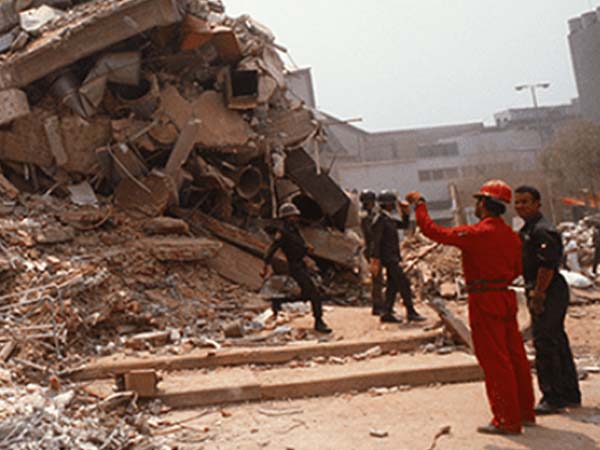Coastal Border Displacement on the West Coast of Ireland
Wednesday, February 16, 2022 11:00 am EST
Subscribe to the ThinkND podcast on Apple, Spotify, or Google.
Featured Speakers:
- Lisa Caulfield, Director of the Kylemore Global Centre in Connemara, Ireland, University of Notre Dame
- Andrew Kennedy, Professor of Civil and Environmental Engineering and Earth Sciences, University of Notre Dame
The second virtual event of Global Dialogues: The Worsening Water Crisis was moderated by Lisa Caulfield, Academic Director for Notre Dame International (NDI) Kylemore, Ireland and featured special guests Andrew Kennedy, Notre Dame Professor of Civil and Environmental Engineering, Mary Bourke, Trinity College Dublin Professor of Geomorphology, and James Hertrich, University College Dublin Professor of Mathematics and Statistics. The goal of this session was to expand on these professors’ current research and its three main domains: 1) the effect of coastal boulders on human activities, 2) the record of climate change that these boulders leave on the environment, and 3) the future use of boulder displacement knowledge to predict storm’s impacts on the coast.
The event consisted of a free-flowing discussion and Q+A session with Professors Kennedy, Bourke, and Hertrich, led by Director Caulfield. She began by asking Professor Kennedy about how he became involved in the coastal boulder displacement in Ireland and what makes this region so unique for this phenomenon. Prof. Kennedy mentioned that these boulders are displaced more frequently in Ireland than anywhere else around the world because of the high frequency of coastal storms in the region. He explained how these boulders serve as a record of climate activity throughout history, if analysts know how to decipher the intricacies of these deposits. For Prof. Kennedy, the future of boulder research looks like delving into the specific conditions that might elicit these displacements, which could help future human development endeavors. The coast of Ireland represents the perfect location for this research due to abundance of boulders and easier coastline access compared to other regions around the globe. Director Caulfield went on to ask Prof. Kennedy about the more definitional viewpoint of boulders and how we could determine whether it is just an actual boulder displacement. Prof. Kennedy stated that there are different ways of determining boulder identity, but that typically research cares about the largest boulders that can move the farthest inland since those are the hardest to displace.
Director Caulfield went on to ask Prof. Bourke to elaborate on the uniqueness of the Irish coastline in terms of boulder displacement research. She describes how Ireland, geographically, is at the frontline of all the weather systems coming out of the Atlantic. They are the first hit by these storms and adverse weather, which consists of massive winds and rain. Bourke goes on to describe the characteristics of the crenulated coastline, which make it ideal for these boulder displacements. The impact of these storms have multiplied over the years, as the intensity and quantity of storms have increased as an effect of climate change. Director Caulfield went on to ask about how the smaller storms that confront Ireland might actually be more harmful. In response, Prof. Bourke outlines nuisance floods, which have costlier and more damaging impacts on regular human activities than bigger storms.
Director Caulfield introduces Professor Herterich to discuss some of his mathematical models. He explains how multiple processes are important in the calculation of these models, including storm wave generation, waves becoming funneled into bays, and amplitude of the overall waves. Prof. Herterich describes that Irish waves have a bigger amplitude than many other coastlines, which show how high these boulder displacements can occur on the west coast of Ireland.
Circling back to Prof. Kennedy, Director Caulfield asks him to explain the context of climate change in these boulder displacement occurrences. The first priority for his lab is to link climate change with boulder displacement. Starting from this baseline, Prof. Kennedy can find a way to use these boulders to predict climate change in the future, as well as discover climate conditions in the past. In addition, they can decipher the climate conditions that caused boulder deposits in other regions of the world. Director Caulfied goes on to ask about how these boulders actually become displaced from the coastline. To which Prof. Kennedy replies that the pressure exerted by the waves on the boulder, once the waves have decelerated, causes the boulder to be overcome by the force and ultimately moves it in the direction of least resistance.
Director Caulfield and the panel of Prof Kennedy, Bourke, and Herterich finished the event with questions from the audience, including questions surrounding the changing intensity of waves and storms due to climate impacts, the interdisciplinary approach to boulder displacement and climate change as a whole, and the type of technology which is utilized to access data and benefit the research.
- “The Irish coastal boulders are unique because there are so many of them and they are forced by winter storms every year.” (Kennedy, 7:13)
- “These deposits are everywhere, and they are a record of what has happened over the past couple of hundred years if we can decipher it.” (Kennedy, 8:59)
- “Very often you look at the farthest inland that things go, and whatever the largest size is that you can show move a couple hundred meters inland, those are the ones you care about” (Kennedy, 10:41)
- “There are a lot of models that suggest things are going to get a little fierce. Waves when they do happen will be bigger, so we have to prepare ourselves.” (Bourke, 17:17)
- “You’ve got these small little things [storms] that just kind of peter along, and once every two years they do a little bit of work.” (Bourke, 18:22)
- “Each and every day, those rocks are doing a little bit of work to wear away that bedrock” (Bourke,19:53)
- “Even just on the near shore, we’ve measured waves that are kind of 10 meters high and a depth of over 40 meters. So, when you think of what that means, that is a huge displacement of water. And it’s that transition from the near shore to the onshore that’s really critical” (Herterich, 25:50)
- “So in terms of are we seeing increased frequency, the answer would be: not yet. RIght now, what our lab’s biggest priority is to link boulder deposits to climate, both the environmental climate and the wave climate. (Kennedy, 28:22)
- “Things like this [boulder displacements] from storms and tsunamis, we can use those to say that if this happened in the past. We can find out how often it happens and find out how often it will happen in the future. (Kennedy, 31:08)
- “Globally, there is this increase in wave energies, in extreme temperatures, and extreme hydrological events (too much water and too little water).” (Bourke, 42:07)
- “It’s essential. We’re not going to make any progress in tackling these issues without a broader approach to it. Both from the social sciences, science humanitary, medical science, etc.” (Bourke, 43:14)
Related Content
Climate Change and The Limits of Narrative
Join the Kellogg Institute for the introductory session of a workshop refining Kellogg Faculty Fellow Roy Scranton’s draft book project “Ethical Pessimism: Climate Change and...
View EventA Brave New World of AI Governance
Explore the connection between data, geopolitics and governance, regulation, self-regulation while discovering examples of good and bad practices in various sectors, such as...
View EventAlgorethics: potentiality and challenges in the age of AI
Explore the possibilities and challenges in ethical governance of AI through algorethics. Algorethics is a term that has been developed since 2018 to denote the need for a study...
View Event

